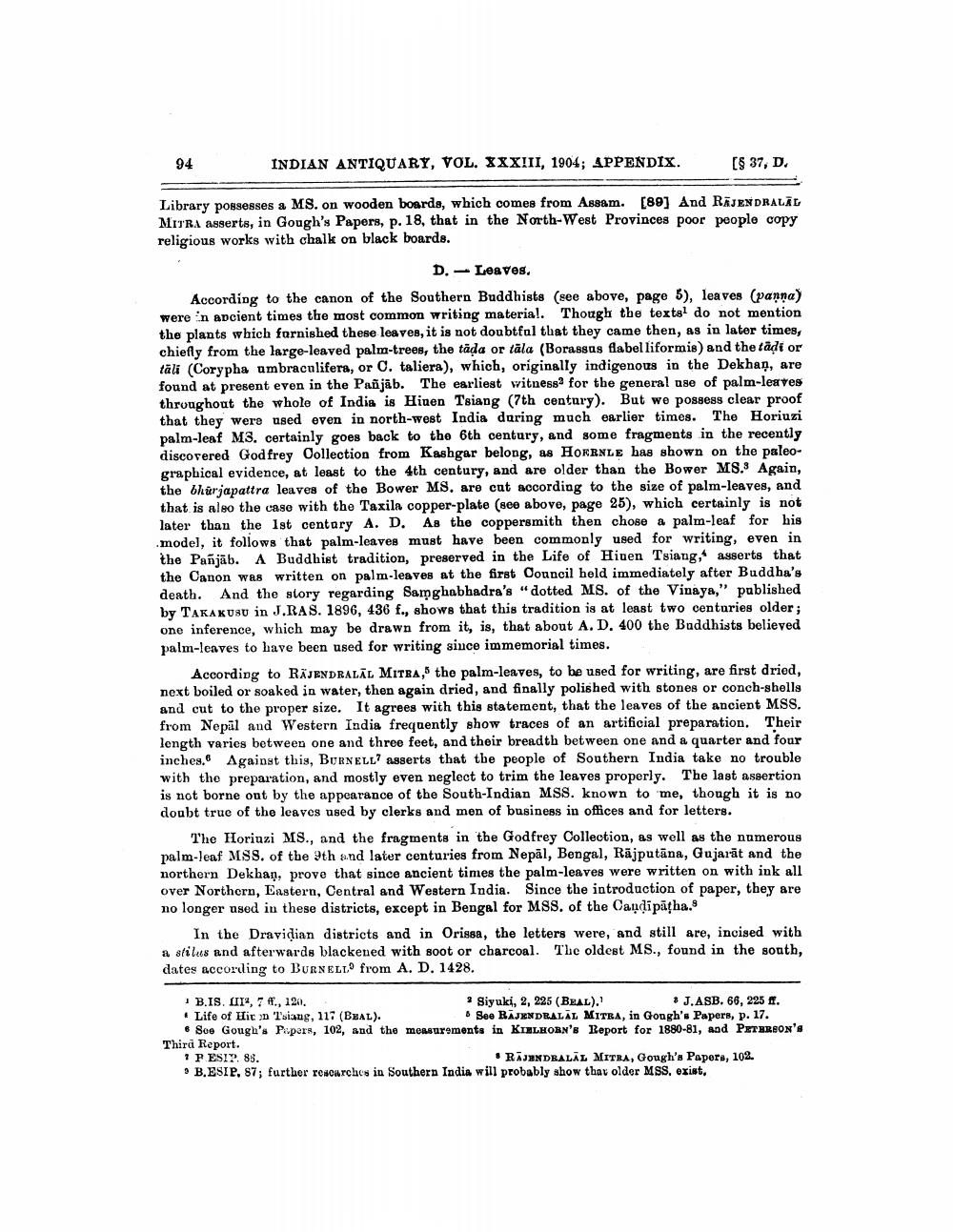________________
94
INDIAN ANTIQUARY, VOL. XXXIII, 1904; APPENDIX.
[$ 37, D.
Library possesses a MS. on wooden boards, which comes from Assam. [89] And RAJENDRALAL MITRA asserts, in Gough's Papers, p. 18, that in the North-West Provinces poor people copy religious works with chalk on black boards.
D. - Leaves.
According to the canon of the Southern Buddhists (see above, page 5), leaves (panna) were in ancient times the most common writing material. Though the textel do not mention the plants which fornished these leaves, it is not doubtful that they came then, as in later times, chiefly from the large-leaved palm trees, the tada or tāla (Borassus flabel liformis) and the tadi or tāli (Corypha umbraculifera, or C. taliera), which, originally indigenous in the Dekhaṇ, are found at present even in the Pañjāb. The earliest witness for the general use of palm-leaves throughout the whole of India is Hinen Tsiang (7th century). But we possess clear proof that they were used even in north-west India during much earlier times. The Horiuzi palm-leaf M3. certainly goes back to the 6th century, and some fragments in the recently discovered Godfrey Collection from Kashgar belong, as HOERNLE has shown on the paleographical evidence, at least to the 4th century, and are older than the Bower MS. Again, the bharjapattra leaves of the Bower MS, are cut according to the size of palm-leaves, and that is also the case with the Taxila copper-plate (see above, page 25), which certainly is not later than the 1st centary A. D. As the coppersmith then chose a palm-leaf for his .model, it follows that palm-leaves must have been commonly used for writing, even in the Pañjāb. A Buddhist tradition, preserved in the Life of Hiuen Tsiang, asserts that the Canon was written on palm-leaves at the first Council held immediately after Buddha's death. And the story regarding Samghabhadra's "dotted MS. of the Vinaya," published by TAKAKUSU in J.RAS. 1896, 436 f., shows that this tradition is at least two centuries older; one inference, which may be drawn from it, is, that about A.D. 400 the Buddhists believed palm-leaves to have been used for writing since immemorial times.
According to RÄJENDRALĀL MITRA, the palm-leaves, to be used for writing, are first dried, next boiled or soaked in water, then again dried, and finally polished with stones or conch-shells and cut to the proper size. It agrees with this statement, that the leaves of the ancient MSS. from Nepal and Western India frequently show traces of an artificial preparation. Their length varies between one and three feet, and their breadth between one and a quarter and four inches. Against this, BURNELL? asserts that the people of Southern India take no trouble with the preparation, and mostly even neglect to trim the leaves properly. The last assertion is not borne ont by the appearance of the South-Indian MSS. known to me, though it is no doubt true of the leaves used by clerks and men of business in offices and for letters.
The Horiuzi MS., and the fragments in the Godfrey Collection, as well as the numerous palm-leaf MSS. of the 9th and later centuries from Nepal, Bengal, Rājputāna, Gujarat and the northern Dekhan, prove that since ancient times the palm-leaves were written on with ink all over Northern, Eastern, Central and Western India. Since the introduction of paper, they are no longer used in these districts, except in Bengal for MSS. of the Candipātha.
In the Dravidian districts and in Orissa, the letters were, and still are, incised with a stilus and afterwards blackened with soot or charcoal. The oldest MS., found in the south, dates according to BURNELLfrom A. D. 1428.
B.IS. 114, 74., 120.
* Siyuki, 2, 225 (BEAL).
* J.ASB. 66, 225 f. • Life of Hic in Tsiang, 117 (BEAL).
• See BAJENDRALAL MITRA, in Gough's Papers, p. 17. . Soe Gough's Paupers, 102, and the momuremonts in KIALHORN's Report for 1880-81, aad PETHRON'S Third Report. P ESIX. 85.
RJUNDRALAL MITRA, Gough's Papers, 102. . B.ESIP, 87; further rescarches in Southern India will probably show that older MSS. oxist,




